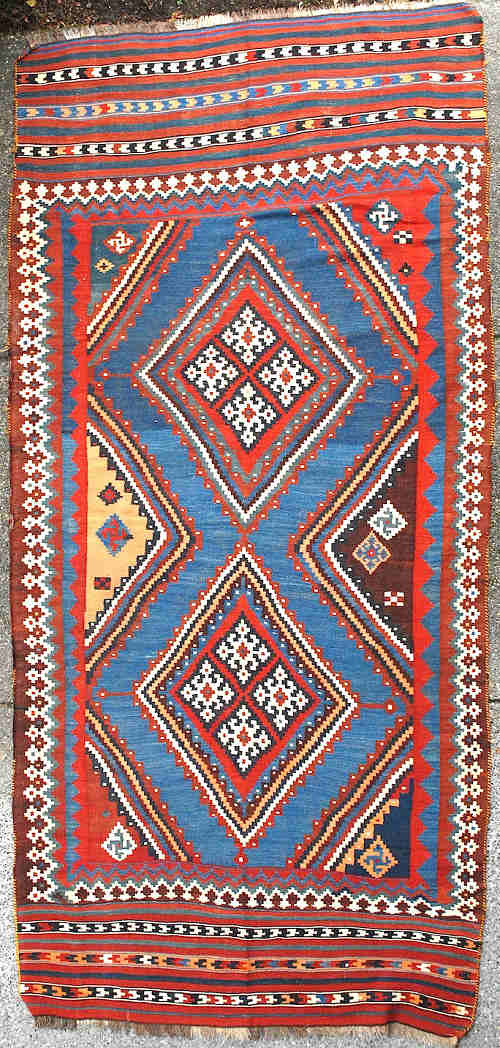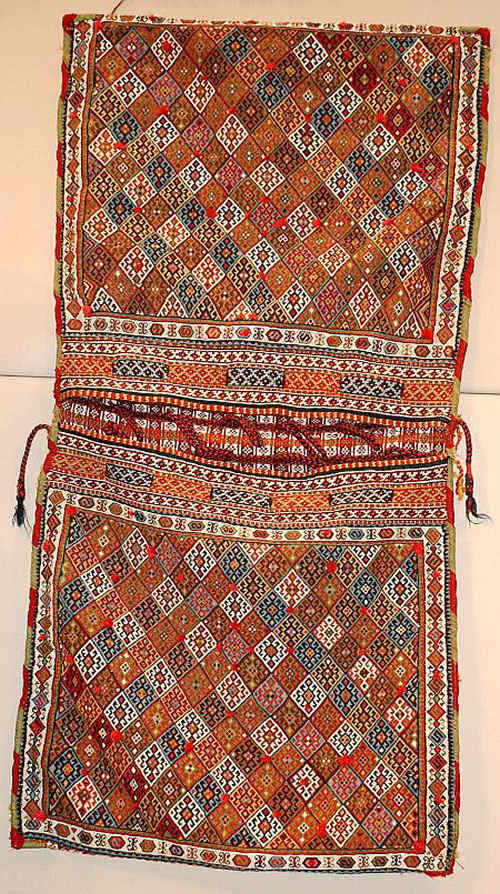by Patrick
Weiler
Why
are there so many Qashqa'i, Bakhtiari, Afshar and Luri kilims, but
almost no kilims from the Khamseh Confederation of SW Iran?
All of these groups wove salt bags, khorjin, chanteh, sofreh and pile
rugs.
One might think that the functions which kilims performed for these
other
tribes would be universal to all of the tribes in the SW Iran region.
They mostly all used the same type of black goat hair tent, similar to
this Qashqa'i tent shown on Jozan.net
Here is a picture from Majid, a rug manufacturer, visiting with a Qashqa'i woman weaving a kilim:

The
horizontal ground loom was likely used by Khamseh as well.
Let's start with a brief primer on the Khamseh (aka Khamsa)
Confederation of SW Iran:
Khamseh is Farsi for five, and the Confederation consists of five
groups or tribes from the region of Fars province, created in the early
1860's at
the urging of the British, to offset the power of the Qashqa’i. The
Confederation lasted until around WWII.
The five groups are the Turkic-speaking Baharlu and Inanlu
(Ainallu/Imanlu), the Arab and the mixed ethnicity Basseri and Nafar.
Wikipedia says: “The
Khamseh tribes were a mixture of Turks, Luri, and Arabs, but they all
came to be called Arabs in contrast to the Turkic Qashqa'i.”
There is also an unrelated NW Iranian Khamseh province, between Kazvin
and Tabriz, with mostly Kurdish villages.
Here is a US Government map from the WWII era showing tribal regions of Iran

It shows Khamseh living east of the Qashqa'i and west of Kirman, where their Afshar influence came from.
Most of the
Khamseh products in the marketplace are attributed to Basseri, Baharlu
and Arab, with few ascribed to the Inanlu, and almost none to the
Nafar, although MacDonald, author of Tribal Rugs, Treasures of the Black Tent, says the Nafar produced fine kilims and
saddlebags.
Here is a possible Nafar rug, with the shrub motif similar to a Nafar
rug in the book Tribal Rugs by MacDonald, plate 46:

And here is an intriguing bagface sold at the Kossow Rippon Boswell sale as Nafar:

Also Nafar, from the MacDonald book, is this saltbag in soumak:

The book
Kilim, by Hull and Wyhowska, has only one small Khamseh kilim.
Their kilims are described as having dull and limited colors and are
slitweave and sometimes double-interlock. The book notes that “No
attempt has been made to distinguish subtle differences in weave,
colour and finish, or to identify weaves at the time of collection. The
situation is further compounded by the fact that there is usually very
little difference between the Qashqai and Khamsa weavings.”
“Most kilims that can be attributed to the Khamsa with certainty are
woven in slitweave or double interlock, with cotton warps. Sometimes
white cotton is used in the field in unusually large areas, with
patterning applied in coloured wool weft inserts. Various stylized
domestic animals are woven into the design especially the murgi
(chicken) and the boteh (paisley) design is popular. Bags and trappings
of all sizes are woven, usually in weft-wrapping technique.”
So Hull and Wyhowska say cotton warps are indicative, but in my
experience, I am not familiar with cotton warps in Khamseh rugs or
flatweaves.
Also, double interlocked tapestry is generally accepted as being used
by Bakhtiari and Uzbek weavers. It is possible Hull and Wyhowskamay
have meant dovetailed tapestry - which also is a marker to
differentiate Luri from Qashqa'i slitweave kilims. And, as we have seen,
dovetailed tapestry is also used by Khamseh weavers in their bags.
There was a discussion on Turkotek which showed a Khamseh khorjin that
has a delightful bridge and back in dovetailed tapestry.
If she wanted to, the weaver could easily have forgone the pile
faces and made an entire kilim patterned after only the flatwoven back.
Even Parviz Tanavoli only shows one Khamseh kilim in his Persian
Flatweaves book, page 195, attributed to the Baharlu tribe.

“The Arab
members of this confederation have not made a significant contribution
to gelim-weaving and, while the Persian constituents who comprise the
Baseri, Nafar, Turkish, Imanlu and Baharlu clans have had some role in
gelim-weaving, it is insignificant in comparison to that of the
Qashqa’i.”
Both books mention the proximity to Afshar people (East of Shiraz and
into Kerman province) as an influence in the style of Khamseh kilims,
but the Tanavoli example looks like a Varamin eye-dazzler with SW
Persian-influence end finishes.
So, what flatweaves and kilims can we reasonably attribute to the
Khamseh, and are we just not aware of others that are incorrectly
labeled Qashqa’i, or Afshar or Lur? Many of the tribes in the Khamseh
Confederation were either allied with or aligned against the Qashqa’i
prior to 1862. Many Khamseh pile weavings look a lot like Qashqa’i
work. Here, for example, is a Khamseh saddlebag with a version of the Qashqa’i gul, but with the common Khamseh border:

The back shows mostly plain weave in a brick and red, with some stripes in the middle where they would have been seen from the front. There are also a few pile knots on the back, indicating perhaps a good luck charm or evil eye device.

Here is a very large Khamseh bag, known as a rakat, of countered soumak:

It has the
common Khamseh border of pairs of birds confronting an hourglass as
seen in the khorjin above. The white is cotton, but the warp is wool.
This is quite a heavy
weaving for a flatweave. It is 57” wide by 27” tall – over four feet
wide and two feet tall. Unfolded, it would be about half the size of a
4x8 kilim. I am not familiar with large kilims which resemble this
design that could be called Khamseh, but there is no reason this weaver
couldn’t have made a kilim with this design.
Here is a Khamseh “cradle”, with soumak borders and the field designs
of inlaid brocading:

Here is a
second Khamseh “cradle”, of soumak and diagonal wrapping:

There is a Khamseh cradle of this type in a museum diorama, from a Basseri Khamseh web site.

These cradles are the size of a small kilim, but were not designed for
floor use. They probably got used on the floor of western homes when
they made their way to the market.
There is another picture of one in use here:

It is from a NERS exhibition for Acor 8.
Are there actual full-size Khamseh kilims with these construction
features and
designs, or did they make their kilims more like their neighboring Qashqa’i?
This next piece is a small soumak chanteh which may be Khamseh and has
features similar to the second cradle, especially the S border:

Here is a
chanteh with a similar design on one face, unfolded. It appears to have
sustained a substantial bite, probably from a lion. Or maybe not.

With so little to go on, here are a couple of kilims which are from
neighbors of the Khamseh.
This first one has the characteristics of a Luri kilim in terms of the
dovetailed tapestry weave technique, but looks like a Qashqa’i kilim.

Yes, it is
possible that it is actually a Khamseh kilim and not Luri after all. It
mimics the Qashqa’i style, but not the slit-weave tapestry construction
of a Qashqa’i kilim. It does have the darker warps also distinguishing
it from a Qashqa'i product.
You can find a Turkotek salon on these types of flatweaves here.
The next one is Bakhtiari or Lur, with a typical Bakhtiari major border:

The size would lend itself to use in an open-front, wide but shallow goat-hair tent such as the one shown on the NERS ACOR 8 exhibition:

One can only occasionally find kilims attributed to Khamseh in the market. Here is one currently for sale labeled Chamseh. It looks a lot like a Qashqa'i weaving, but with a darker tonality and less formal drawing:

Also note the
end finishes, with the typical Qashqa'i frieze of blue and white
devices, but also with the common Khamseh treatment of a row of this
same device in red and green, along with darker warps.

For some more examples of what may be khamseh work, there is plate 104
in From the Bosporus to Samarkand, but with no tribal attribution.
Notice the S border, similar to other Khamseh pieces:

It is
reproduced in color on this website, in a presentation by longtime
expert and author, Mike Tschebull, on Transport and Storage Bags from Southwest Iran.
Here is a Khamseh pile chanteh with the back in dovetailed tapestry, the same technique we ascribe to Luri kilims:
It is from a delightful blog.
This next
piece is on the market. It is a khamseh flatweave of a type called
“shiraki” or “needlework”. It appears to be of newer manufacture and is
a type I am not familiar with.

There is a
book, Nomads of South Persia, The Basseri Tribe
of the Khamseh Confederacy, by Fredrik Barth, which is reproduced
on-line at this web page.
He spent time in 1958 with the tribe and one reviewer calls it
“informative but incredibly boring.”
With as much output of pile rugs, bags and trappings as the Khamseh
weavers produced, one would think that an equal amount of kilims had
been made, but perhaps just not ascribed as such when they were
collected and sold.
So, are there any actual Khamseh Kilims which are similar in
construction or design to these mostly smaller, utilitarian pieces but
may be mislabeled?
Have they been living among us, undetected, unknown and unappreciated
for all these years?
As Brian MacDonald put it in Tribal Rugs;
“The rugs and other woven artefacts of both the Baharlu and Ainalu
tribes are difficult to attribute exactly, at the time of writing
(1997) The study of weavings of the “Khamseh Confederacy” is still in
its infancy.”
I would add that it hasn’t advanced much since then, either.